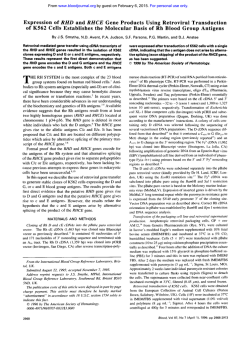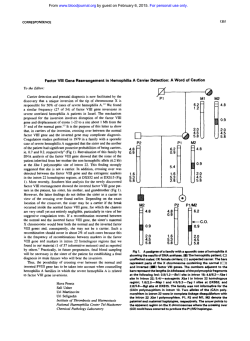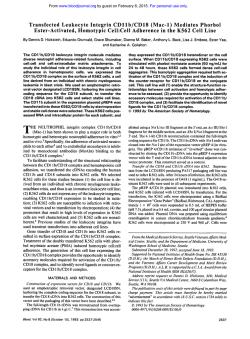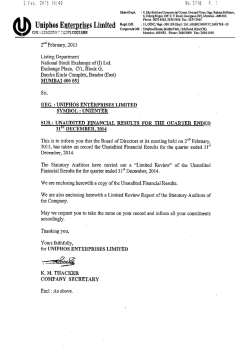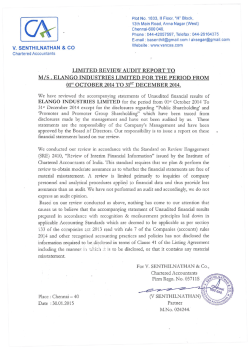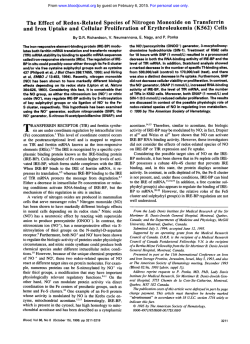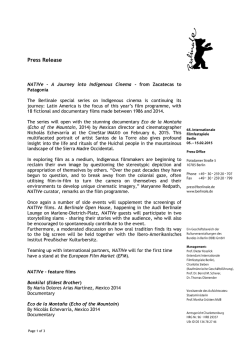
Regulation of cy2 Integrin Gene Expression in Cells
From www.bloodjournal.org by guest on February 6, 2015. For personal use only. Regulation of cy2 Integrin Gene Expression in Cells With Megakaryocytic Features: A Common Theme of Three Necessary Elements By Mary M. Zutter, Audrey A. Painter, William D. Staatz, and Ying L. Tsung The adl integrin mediates interactions between cells and the extracellular matrix molecules, collagen and/or laminin. The a& integrin is expressed in a variety of cell types, but in cells of hematopoietic lineage, expression is restrictedto megakaryocytes and platelets. Increased expression of the a& integrin during megakaryocyticdifferentiationis a consequence of transcriptional activation of the az gene. We have begunto characterizethe role of the 5’ flanking region of the azintegrin gene in regulating expression during megakaryocyte differentiation. A 5-kb fragment of the 5’ region directs both cell type and differentiation-dependentexpressionofareportergene in the pluripotent hematopoietic K562 cells upon megakaryocytic differentiation and in the 5’ megakaryocyticcellline, Dami. Analysisofaseriesof deletion mutants indicatesthat expression ofthe azintegrin gene in cells with megakaryocytic features requires acore promoter region, a silencer region, and megakaryocyticenhancers in the distal 5‘ end. The organization of these three distinct regulatory regions the of a2promoterlenhancer suggests a commontheme for megakaryocytic gene regulation shared with other megakaryocyte-specific proteins, including allb integrin subunit and platelet factor 4. 0 1995 by The American Society of Hematology. D protin Iband the megakaryocyte/platelet-specific integrin aIIbP3.’5 We now show that Damicells constitutively express the azpI integrin protein and mRNA and that they use the receptor for adhesion to collagen. We recently reported the characterization of the first 961 bpof the 5’ flanking region of the a2 integrin gene. This region can direct cell-type-specific promoter and enhancer activity in cells of epithelial origin, but not in K562 cells induced to become megakaryocytic.’6 From these earlier studies, three major questions remained unanswered: ( 1 ) Is our phorbol-ester-induced model of megakaryocytic differentiation relevent to other models of megakaryocytopoiesis? (2) Is there a silencer/repressor functioning in cells of hematopoietic lineage? (3) Where are the enhancers that are necessary for activity in megakaryocytes? To begin to answer these questions, we have now compared the activity of an expanded series of deletion mutants of the 961-bp a2 promoter construct in Dami cells to phorbol-ester-induced and uninduced K562 cells. Within this region is a silencerhepressor active in both models of megakaryocytic differentiation. In addition, we have extended our analysis of the 5’ flanking region of the a2 promoter to include an additional approximate 4.0 kb of 5’ flank extending from -5,000 bp to + 109 bp. This genomic fragment contains enhancers necessary for a2 integrin gene activity in cells with megakaryocytic differentiation. Based on our results, we propose a model for the megakaryocytic regulation of the a2 integrin gene that requires a core promoter, followed by a strong silencer, and megakaryocytic enhancers in the distal 5’ flank. IFFERENTIATION and maturation of hematopoietic precursors into megakaryocytes is associated with expression of megakaryocyte-specificproteins, development of a granules, endomitosis, and, subsequently, the release of platelets from the cell surface.’.’ The a Z p Iintegrin, a member of the integrin family of heterodimeric adhesive protein receptors, is expressed on platelets and megakaryocytes during this process of megakaryocytic maturation. The a2p,integrin on platelets serves as a cell surface receptor for collagen, required for normalhemostasis.”’Although a$, is expressed on a variety of cell types, including epithelial and mesenchymal cells, on cells of the hematopoietic lineage, it is restricted to megakaryocytes and platelets.’,’” Our understanding of megakaryocytopoiesis has been facilitated by the development of cell lines with megakaryocytic properties. The leukemic cell line, K562, derived from a patient with chronic myelogenous leukemia, represents a pluripotent hematopoietic cell that acquires megakaryocytic properties including increased surface expression of the a2pI integrin as well as glycoproteins IIb-IIIa and Ib in the presence of phorbol dibutryate.“”’ In earlier studies, we showed that the increased expression of the azpIintegrin after phorbo1 ester induction of K562 cells is a consequence of increased steady-state levels of a2 mRNA due to transcriptional activation of the a2gene.I4 In contrast to K562 cells, which acquire megakaryocytic properties after phorbol ester induction, the Dami cell line, developed from the peripheral blood of a patient with megakaryoblastic leukemia, constitutively expresses megakaryocytic proteins, including glycoFrom the Department of Pathology, Washington University School of Medicine, St Louis, MO. Submitted January 12, 1995; accepted May 9, 1995. Supported bygrantsfrom the National Institutes of Health (HL51450) and the American Heart Association. Address reprint requests to Mary M. Zutter, MD, Box 8118, Department of Pathology, Washington Universiry School of Medicine, 660 S Euclid Ave, St Louis, MO 63110. The publication costs ofthis article were defrayed in part by page charge payment. This article must therefore be hereby marked “advertisement” in accordance with 18 U.S.C. section 1734 solely to indicate this fact. 0 1995 by The American Society of Hematology. 0006-4971/95/8608-0126$3.00/0 3006 MATERIALS AND METHODS Cell culture and transfection assays. The K562 cell line was obtained from the American Type Culture Collection (Rockville, MD). The Dami cell line was a gift of Dr Robert I. Handin (Harvard Medical School, Boston, MA). Both cell lines were propagated in RPM1 1640 medium. Megakaryocytic differentiation of K562 cells was induced by the addition of 40 nmoVL phorbol dibutyrate in dimethyl sulfoxide, as previously described.’’ The K562 and Dami cell lines were transfected by electroporation using a BTX Electro Cell Manipulator 600 (BTX Inc, San Diego, CA).” Approximately 1.0 to 1.5 x 10’ cells were transfected in RPM1 medium containing 100 mg/mL salmon sperm DNA, 30 pg of plasmid DNA, and 3 pg of Rous sarcoma virus (pRSV)-luciferase DNA by electroporation at 275 V and 600 pF. Cell extracts were Blood, Vol 86,N O 8 (October 75). 1995:PP 3006-3014 From www.bloodjournal.org by guest on February 6, 2015. For personal use only. (I* INTEGRINEXPRESSION 3007 BY MEGAKARYOCYTES harvested after 48 hours. Luciferase activity produced by 10 pL Of the cell lysate in 190 pL of assay buffer (10 mmoVL Mg[OAc]z, 50 mmoVL Tris-MES, pH 7.8, and 2 mmoVL ATP) was analyzed using a Monolight 2010 luminometer (Analytical Luminescence Laboratory, San Diego, CA), as described," and was used to normalize for transfection efficiency. Cell extracts containing identical amounts of luciferase activity were then assayed for chloramphenical acetyltransferase (CAT) activity by the standard method of Gorman et The conversion of chloramphenical to acetylated chloramphenicol was determined by both thin-layer chromatography and differential extraction. Flow cytometry and antibodies. Flow cytometry was performed on a Becton Dickinson FACScan Analyzer and analyzed with Becton Dickinson Consort-30 software (Becton Dickinson, Mountain View, CA). Adherent cells were detached in Versene solution (0.5 mmoV L EDTA in phosphate-buffered saline: GIBCO BRL, Grand Island, NY) at 4°C and washed in calcium- and magnesium-free Hanks' balanced Salt Solution (CMF-HBSS) with 1% bovine serum albumin (BSA). Viable cells were enumerated by trypan blue exclusion, and cells were resuspended in CMF-HBSS to a final concentration of 5 X 10s viable celldml. Cells (5 X lo5 per tube) were labeled with a primary antibody concentration of 5 pg/mL. Fluorescein isothiocyanate (FITC)-conjugated goat antimouse IgG (5 p g / m l ) was used as the secondary antibody. Histograms are based on the analysis of 10,OOO cells. Controls included omission of both first and second antibodies, omission of the first antibody, and use of an irrelevant first antibody. The monoclonal antibody (MoAb) 7E3, which recognizes the a& (IIb-IIIa) and a,@, integrins in a complex-specific manner, was generously provided by Dr Barry S . Coller (State University of New York at Stony Brook, Stony Brook, NY). The P1E6 antibody directed against the az integrin subunit was obtained from GIBCO BRL (Gaithersburg, MD). The 4B4 MoAb reactive with the PI integrin subunit was obtained from Coulter Inc (Hialeah, FL). The FITCconjugated goat antimouse IgG was obtained from TAGO, Inc (San Jose, CA). mRNA analysis. Total cellular RNA was prepared by guanidine thiocyanate extraction and preparative ultracentrifugation, as described." Northern blot analysis was performed by electrophoretic separation of total cellular RNA (15 to 20 pg) in denaturing formaldehyde-agarose gels, transfer of the RNA to Nitroplus membrane (Micron Separation, Inc, Westboro, MA), baking, and hybridizing overnight to 32P-random-primedcDNA probes. The hybridized blots were washed and exposed to film for 1 to 5 days. A partial-length az cDNA clone corresponding to nucleotides 1 through 1289 of the published azcDNA sequence" was previously described.14 The amplified cDNA was ligated into the plasmid pBSSK (Bluescript; Stratagene Cloning Systems, La Jolla, CA) and subjected to double-stranded DNA sequencing using the dideoxynucleotide chain termination method of Sanger et alZ2to establish authenticity. A cDNA corresponding to nucleotides 130 through 2626 of the PI integrin subunitz3was generously provided by Dr Laurence Fitzgerald (University of Utah,Salt Lake City). a2 CATfusion constructs. The promoter and enhancer activity of the 5' flanking region was analyzed by inserting the EcoRI-Ava I1 genomic fragment (-961 to +l09 in relation to the transcription start site at + 1) upstream to CAT structural sequences in the CAT which expression vector pCAT-Basic (Promega, Madison, W), lacks natural CAT regulatory elements.16 Nested deletion mutants of the 1.0-kb construct (pz961-CAT) were generated by restriction enzyme digestion of ~~1,961-CAT the at restriction enzyme sites Psr I(-30), Xma 111 (-92), Sac I1 (-122). Nar I (-223), S m I (-351), Bgl I1 (-549), and Acc I (-776). Cytomegalovirus (CMV)-CAT containing the CMV promoter directing transcription of the CAT gene served as a positive control. Cotransfection in the pRSV-luciferase containing the Rous sarcoma virus promoter served as a control for transfection efficiency in all assays. All transfection experiments were performed at least three times and the results are reported as average values relative to the paQ2-CAT construct. A 5-kb BamHYAva I1 genomic fragment representing approximately 5 kb of the 5' flanking region (-5,000 to +l09 in relation to the transcription start site at + l ) was inserted upstream to CAT structural sequences in pCAT-Basic (Promega). Deletion mutants of the 5-kb construct (pcuZ5000-CAT) were generated by restriction enzyme digestion of paz5000-CAT at the restriction enzyme sites Hind111 (-3,739). Stu I (-2,592), and Sac I (-1,426). RESULTS Dami cells express the a2PIintegrin. In our earlier studies, we exploited a model of megakaryocytic differentiation using K562 cells to examine regulation of the azPlintegrin during megakaryocytopoiesi~.~~~~~ The Dami cell line, which was derived from a patient with megakaryoblastic leukemia, is known to constitutively express the platelet-specific glycoprotein IIb/IIIa (01&) and glycoprotein I b . 1 5 We have now analyzed the Dami cell line for expression and regulation of the azPIintegrin. Surface expression of the a2and PIintegrin subunits was determined using flow cytometric analysis and compared with the expression of the a I I bintegrin ~3 in Fig 1A. Both the a2and PI integrin subunits were expressed at comparable levels, but at significantly lower levels than the a,&, integrin. The relative difference in the two megakaryocyte antigens is consistent with the greater number of aId3 receptors on circulating platelets and comparable to the differences we reported earlier for the expression of azPIand at& using the K562 cell model of megakaryocytic differentiation." We also compared the levels of az and PI mRNAs expressed by Dami cells, uninduced K562 cells, and K562 cells induced with phorbol 12,13 dibutyrate for 8 days, as shown in Fig 1B. In contrast to the high level of az and PI mRNA expressed by induced K562 cells, Dami cells expressed low but readily detectable levels of az and PI mRNA. As reported earlier, uninduced K562 did not express detectable levels of az mRNA by Northern blot hybridi~ation.'~ The a2PIintegrin is functional on Dami cells. The a d l integrin serves as a Mg2+-dependent receptor for collagen on platelets and fibroblasts. We showed not onlythat induced K562 cells expressed the azPl integrin, but also that the receptor was f~nctiona1.l~ On the other hand, when uninduced K562 cells were transfected with a full-length az cDNA, the ad1integrin was expressed on the cell surface but did not bind ligand.24Thus, megakaryocytic differentiation is accompanied not only by increased a d l expression but also by changes in the activation state of the receptor. We therefore evaluated the functional state of the ad1receptor expressed on Dami cells. Dami cells adhered to collagen in the presence of Mg2+, asshown in Fig 2A. The cells failed to adhere to collagen when CaZ+was substituted for Mg2+ and did not adhere to BSA substrates. To verify that the Mgz+dependent adhesion was mediated by the a2P,integrin, adhesion assays were conducted in the presence of inhibitory MoAb. The Mg2+-dependentadhesion to collagen was com- From www.bloodjournal.org by guest on February 6, 2015. For personal use only. 3008 ZUTTER ET AL Fig 1. Dami cells express a& integrin protein and mRNA. (A) Cell surface protein expression was determined by indirect flow cytomehic complex and FllC-conjugated goat antimouse lgG as a analysis using the MoAbs directed against either the a2or f3, subunits or the a& secondary antibody. (B)Northern blot analysis was performed on total cellular RNA from uninduced K562 cells cultured in medium alone for 8 days, induced K562 cells cultured in medium containing 40 nmol/L phorbol dibutyrate for 8 days, or Dami cells. The 8.0-kb a2and 4.2-kb mRNA were detected using '*P-labeled cDNA probes. The corresponding ethidium bromide-stained gels illustrate that equivalent amounts of RNA were present in each lane. pletely blocked by the inhibitory anti-a2 MoAb 6F1 (Fig 2B). In contrast, a control anti-a5 MoAb (PlD6) failed to inhibit adhesion. Therefore, Dami cells adhered to collagen via an adIintegrin-mediated mechanism. Regulation of the a2subunit gene in Dami cells is similar to that in phorbol-ester-induced K562 cells. In our initial characterization of the 5' flanking region of the a2integrin gene, we identified a 961-bp fragment of the gene extending from bp + 1 to bp -961 that directed cell-type- and differentiation-specific expression of a reporter gene in epithelial cells but not in induced K562 cells.I6 In this earlier study, the pa292-CAT construct directed high-level enzymatic activity in induced K562 cells. However, the longer constructs, ie, pa2549-CAT, pa2776-CAT, and pa2961-CAT, generated low to undetectable activity in either uninduced or induced K562 cells. To compare the K562 model of megakaryocytic differentiation to Dami cells, we compared the ability of the constructs pa230-CAT, pa292-CAT, pa2549-CAT, and pa2961-CAT, outlined inFig 3, to direct reporter gene activity when transfected into uninduced K562 cells, K562 cells induced for 6 days with phorbol dibutyrate, andDami cells. The pattern of CAT activity generated by the mutant constructs was similar inDami cells andin induced K562 cells, as shown as an average of six experiments (Fig 4A and B). Enzymatic activity directed by the pa230-CATconstruct was undetectable in either Dami cells or K562 cells induced for 6 days with phorbol esters. In contrast, the pa292-CAT construct directed high-level CAT activity inbothDamiand induced K562 cells and only low-level enzymatic activity in uninduced K562 cells. The high level of enzymatic activity directed by pa292-CAT was partially silenced by the addition of 457 bp of sequence between -92 and -549. In fact, the CAT activity directed by the pa2961-CAT construct in induced K562 cells or Dami cells was only 7% or 12%, respectively, of that directed by the pa292-CAT construct. Thus, the region between bp -30 and -92 contains elements that are necessary for high-level gene activity in cell lines with megakaryocytic differentiation, but are not celltype specific. As shown earlier, the pa292-CAT construct was active in the breast carcinoma cell line T47-D.I6 Elements between -92 and -549 almost completely silenced activity in induced K562 cells and Dami cells. The silencer was inactive in the breast epithelial cell line. Eventhe longest construct, pa2961-CAT, did not restore the high-level promoter activity necessary to account for the observed 20-fold increase in transcriptional activation of the a2gene in K562 cells upon phorbol ester induction or in Damicells. The From www.bloodjournal.org by guest on February 6, 2015. For personal use only. INTEGRIN EXPRESSION BY MEGAKARYOCYTES (I? 30r 3009 L T COLL BSA 30 C .o U) 20 a) c .U a S 10 n " BSA No Ab P 16 DF61 EDTA Collagen Fig 2. Dami cells adhere to type I collagen via an a& integrinmediated mechanism. (A) The ability of Dami cells to adhere to type I collagen or BSA in the presence of Mg2+f@), CB2+ (01, or EDTA ( W was determined. (B) MoAb 6F1 directed against the a& integrin reduced the Mg2'-dependent adhesion of Dami cells to collagen to the low level observed in EDTA. A control antibody, PlD6, directed against the aspl integrin had no effect. inability of pa2961-CATto mimic the increased transcription of the a2gene in induced K562 cells or Dami cells suggested that one or more enhancer elements important for the regulation of the a2gene in our models of megakaryocytic differentiation must be present in yet unidentified regions of the a2 promoter. Silencer activity for cells of hematopoieric lineage is located between bp -92 and -351. To begin to dissect the silencer activity located between bp -92 and -549, we constructed a series of deletion mutants pa2122-CAT, pa2223CAT, and pa2351-CAT tightly spaced between bp -92 and -549 (Fig 3). The promoter activity of these CAT deletion mutants was determined in K562 cells withandwithout phorbol dibutyrate and in Dami cells. CAT enzymatic activity in cells with megakaryocytic differentiation decreased with the addition of increasing sequence between -92 and -351 (Fig 4A and B). In contrast to the pa292-CAT construct, which directed the highest enzymatic activity, the pa2122-CAT, pa2223-CAT, and pa2351-CAT directed enzymatic activity at approximately 27% to 34%. 5 % to 12%, and 2% to 8%, respectively, of the paQ2-CAT construct in both Dami cells or in K562 cells induced for 6 days with phorbol dibutyrate. Sequence analysis of the region between -92 and -351 showed a single API site between -92 and -122, one NFI-like site between -122 and -223, and a second NFI-likesite between -223 and -351. CCAATbinding sites for NFI have been implicated in silencing a number of genes, including the rat growth hormone gene, the human retinal binding protein, the mouse Sparc (osteonectin) gene, the chicken &globin gene, the mouse Ren-Id gene, and the mouse a2 (I) collagen gene.2s In these genes, the NFI-like consensus sequence serves as anegative regulatory element that suppresses gene activity in a cell-type-specific manner. Further studies are under wayto assess the role of these NFI-like sites in the silencing of the a2 gene in hematopoietic cells. Other potential elements in the region between -92 and -351 that could modulate increasing silencer activity are the AP2 and Spl sites. In summary, we have identified a strong silencer active in cells of hematopoietic lineage that requires multiple elements for full activity. Megakaryocyte-specijc enhancers are located in the far distal 5' yanking region. As discussed earlier, the lack of essential regulatory elements to override the silencer activity in cells with megakaryocytic differentiation suggested that we were lacking important regions of the a2promotedenhancer. We therefore sought to identify additional elements in the distal 5' flanking region. A restriction mapof the original 15-kb phageclone'' indicated that a BamHI site was present approximately 4 kb 5' to the EcoRI site at -961. To determine if the additional 4-kb region contained elements important for megakaryocytic gene activity, the BamH1-Ava I1 genomic fragment spanning the region from -5,000 to +l09 was placed upstream of CAT structural sequences in the construct pa25000-CAT (Fig 3). The promoter activity of pa25000-CAT construct was analyzed in uninduced and induced K562 cells. This region conferred strong promoter activity nearly comparable to that of the strong viral promoter CMV in induced K562 cells but exhibited little activity in uninduced K562 cells (Fig 5). Additional 5' deletion mutants between -961 and -5,000 (Fig 3) localized strong megakaryocytic enhancer activity to the region between bp -1,426 and -2,592. Although the pa21426-CAT construct increased activity slightly, the pa22592-CAT construct restored high-level promoter activity in the induced K562 cell model. The pa22592-CATconstruct was 13.3-fold more active than the pu2961-CAT construct in induced K562 cells and 9.3-fold more active in induced versus uninduced K562 cells (Fig 5). Little additional activity was gained by elements extending beyond -2,592. The strong promoter activity generated by elements between - 1,426 and -2,592 indi- From www.bloodjournal.org by guest on February 6, 2015. For personal use only. 3010 ZUTTER ET AL BamHI -5000 Avall I +!!AT‘, m(t, a -5000 +l *B -3739 -2592 -e -1426 ‘h integrin gene Pa, 5000-CAT Pa, 3739-CAT pa, 2592-CAT Fig 3. Aschematic diagram of the a2 promoter-CATconPa2961-CAT structs. The construct p&OOO-776 CAT contained the entire 5’ Po, 776-CAT flanking regionwith 109 bp of 5’-54?A& Po, 549-CAT untranslatedregion upstreamto the CAT structural gene.Con-35po2351-CAT structs pa3739-CAT, pa22592-223* Po, 223-CAT CAT, and pa21426-CAT were derived from pa,5000-CAT. Conpa, 122-CAT structs pa2778-CAT, pa2549-92 CAT, wJ51-CAT. Wz122-CAT. pop92-CAT and aZ92-CATwere derived from -3% Po, 30-CAT the construct, pa2961-CAT.’E -961 pap 1426-CAT a +l a -122a % cates that enhancers required for activity of the a2 integrin gene in cells with megakaryocytic differentiation are located in this region. Sequence analysis of the region between -961 and -3,739 confirmed the location of numerous potential binding sites for ubiquitous as well as megakaryocyte-specific transcription factors (Fig 6). Three perfect consensus sequences for binding the GATA family of transcription factors were identified between -961 and -2,592.26 In each case, these potential GATA boxes are located in close proximity to concensus sequences for either AP1 or AP2. One or more upstream GATA sequences are also required for promoter/ enhancer activity of the megakaryocyte-specific prot e i n ~ . * ~The - ’ ~ numerous AP1 concensus binding sites, two of which are separated by only 8 bp, suggest NF-E2 binding NF-E2,a second erythroidmegakaryocytic transcription factor, is required for megakaryocytic differentiation and platelet p r o d ~ c t i o n Other . ~ ~ potential sites include concensus sequences for NFKb, CAAT binding protein, and one estrogen receptor (ER) half-site. In addition to potential binding sites for transcription factors, two clusters of binding sites for either the enzyme, topoisomerase I1 (Top0 11) or binding proteins for scaffoldmatrix associated regions (SARsMARs), are located in this distal 5‘ The megakaryocytic features of Dami cells can be augmented by phorboE esters. Exposure of Dami cells to phorbo1 esters is known to increase expression of platelet membrane glycoproteins Ib, cyllb, andvon Willebrand factor, suggesting that the adl integrin may be similarly effected.’ We confirmed using flow cytometric analysis that the addition of 12,13 phorbol dibutyrate to Dami cell cultures for 2 days markedly increased the expression of the a2 integrin on the cell surface (Fig 7A). We compared the activity of the a2promoter constructs in uninduced and induced Dami cells. Exposure of Dami cells to phorbol dibutyrate for 4 days increased the activity of the pa292-CAT construct containing the core promoter/enhancer region by 7.0-fold (Fig 7B). The silencer domain greatly diminished CAT activity in induced Dami cells in a similar stepwise manner as that seen in uninduced Dami cells and induced K562 cells. However, the silencer failed to completely repress all promoter activity in induced Dami cells. The megakaryocyte-specific enhancer elements in the distal 5‘ flank located between - 1,426 and -2,592 conferred high-level promoter activity in induced Dami cells (comparable to the high level of activity observed in induced K562 cells) and low-level activity in uninduced Dami cells (Fig 7B). In a manner similar to that observed in uninduced K562 cells, the region between -2,592 and -3,739 augmented activity in uninduced Dami cells, butonly twofold. Therefore, the region between - 1,426 and -2,592 contains strong megakaryocyte-specific enhancers necessary to mimic the low level of transcriptional activation of the a2gene observed in uninduced Dami cells and the high level of activity observed in induced Dami cells. DISCUSSION The a2PIintegrin, a collagen receptor on platelets and megakaryocytes, is essential for normal hemostatic function of platelets. To understand the regulation of a& integrin expression during megakaryocytic differentiation, we identified the 5’ flanking region of the a2integrin gene and showed that the elements within the first 961 bp could direct celltype- and differentiation-dependent expression in cells of epithelial origin but could not recapitulate the expression of a2integrin in K562 cells induced with phorbol dibutyrate to become megakaryocytic.I6To focus on the molecular mechanisms controlling expression of the a& integrin gene during megakaryocytic differentiation, we have now compared the expression of the a2integrin gene in induced K562 cells with that in Dami cells. Dami cells, a committed megakaryoblast, constitutively express megakaryocytic features, including the a& integrin protein and mRNA.’’ To determine the molecular regulation of adl integrin in cells with megakaryocytic differentiation, we compared the activity of the original promoter/enhancer constructs (pa230-CAT, pa*92-CAT, From www.bloodjournal.org by guest on February 6, 2015. For personal use only. cr2 301 1 INTEGRINEXPRESSIONBYMEGAKARYOCYTES pa2549-CAT, and pa2961-CAT) as well as a series of nested deletions between bp -92 and -549 in Dami cells with that of uninduced and induced K562 cells. Similar regions of the a2integrin gene are required for expression and silencing of expression in both Dami cells and induced K562 cells. These studies suggest that regulation of the a2integrin gene in cells 9.0 8.5 8.0 - 7.5 - 1 \ ' 8.9 8.8 8.7 2, --> 8.6 8.5 f " 2 t9 L 1.0 0.9 0.8 F 0.7 ';m 0.6 0.5 0.4 0.3 0.2 0.l nn Fig 5. The distal 5' flank of theai gene directed promoter activity in cells with megakaryocytic features. Activity of the constructs pmZl426-CAT,pa22592-CAT,pa23739-CAT, and pa25000-CAT was compared with that of prraO-CAT, pa292-CAT, and pa2961-CATin uninduced K562 cells (R) and K562 cells induced for 6 days with 40 nmol/L phorbol dibutyrate ( W . CAT activity relative to the pa292CAT construct in induced K562 cells is plotted. 6.3 6.2 6.1 6.0 2, .-> 5.9 L I t; 1.0 24 0.9 E 0.6 0.8 g 0.7 =a: 0.5 0.4 0.3 0.2 0.1 nn Fig 4. The a, integrin promoter activity in cells with megakaryocytic differentiation. pa2961-CAT, pa2549-CAT, pa.&l-CAT, pa2-223CAT, pazl22-CAT, pa292-CAT, and pa,BO-CAT were transfected in parallel with the CMV-CAT, which contains the strong promoter, viral and CAT-BASIC, which lacks promoter activity, into either uninduced ( W or induced (M) K562 cells IA) or Dami cells (B). Cotransfection with RSV-luciferase was used t o control for transfection efficiency. After 48 hours ofincubation, cell extracts were assayed. After normalization for transfectionefficiency, CAT activity of the constructs was determined using thin-layer chromatography and differential extraction. CAT activity of an average of six experiments relative t o the pu292-CATconstruct in induced K562 cells (A) or Darni cells (B) is plotted. of megakaryocytic lineage is mediated, at least in part, by three functionally distinct domains within the 5' flanking region of the a2 gene. These three domains consist of a strong core promoter located between bp -30 and -92. The core promoter is not cell-type specific. It is followed by a silencer between -92 and -351 that is able to repress promoter activity in cells of hematopoietic lineage. Interestingly, this region is not active as a silencer in nonhematopoietic cells (data not shown)." Additional enhancers in the far distal 5' region are required for high-level megakaryocytic expression of the a2integrin subunit. The identified enhancer and silencer elements are important for the regulation of the a2pIintegrin in cells of megakaryocytic origin, ie,Dami cells, and not simply a response unique to K562 cells or the addition of phorbol esters. This complex scheme of a2 integrin gene regulation, which requires three distinct regions with both positive and negative elements for megakaryocytic activity, resembles the regulation of other megakaryocyte-specific proteins, including the (Yllh integrin subunit and platelet factor 4 (PF4).27-32 Both of these megakaryocyte-specificproteins contain a core promoter domain, followed by a strong silencer, and enhancers required for expression by megakaryocytes in the distal 5' flank. The core promoter region of PF4 and the (Yllh subunit reside between the transcription start site andbp -97 or -99, respectively. This location is almost identical to where we located the core promoter of the a2 integrin subunit gene. Both the PF4 and (Yllh promoters, which are restricted to megakaryocytic lineage, contain a necessary GATA-like site within the core ~ e q u e n c e . ~The ~ . ~GATA ' family of transcrip- From www.bloodjournal.org by guest on February 6, 2015. For personal use only. 3012 ZUTTER ET AL Silencer domain Megakarycyte-specific enhancers -2592 3739 L -1426 -961 L AR CCAN CCAAT Core promoter A -30 -351 -921+1 '129 *l93 I CCAAT Fig 6. A schematic diagram of the distal 5' flank from bp -3,739 through exon 1 of the o2integrin gene. The locations of numerous potential binding sites for ubiquitous as well as megakaryocyte-specific transcription factors are shown. In addition to numerous potential binding sites for AP1 and AP2, three perfect consensus sequences for binding the GATA family of transcription factors are located between -961 and -2,592. Additional potential binding sit- indude consensus sequences for NFA, CAAT binding protein, and four estrogen receptor half-sites. In addition, there are two clusters of binding sites for the enzyme Top0 II and the SARslMARs. The complete DNA sequence of the region from -961 to -3,739 has been submitted to GenBank, Accession No. U31518. tion factors mediates hematopoietic differentiation along erythroid, megakaryocytic, and mast cell lineages, but is not required for myeloid or lymphoid differentiation.26In contrast to the core promoter of the megakaryocyte restricted almand PF4, the core promoter element of the a2integrin, which does not contain a GATA-like sequence, is active in nonhematopoietic cells. Activity of the core region of the cy2 integrin subunit, therefore, may require ubiquitous transactivating factors. Our earlier sequence analysis of this region identified two Spl sites and an AP2 site that potentially are active in this core region.16 Although the cy2 integrin subunit is not megakaryocyte specific, common strategies appear to have evolved to confer megakaryocytic expression. The silencer domain of both PF4 and the (YIIb is necessary for lineage restriction to megakaryocytes. The silencers of both PF4 and a [ l b may repress expression of these genes in ail nonmegakaryocytic cell types.". 82.41 In contrast, the a2 subunit is expressed bymany cell types butnotby cells of hematopoietic lineage, with the exception of platelets and megakaryocytes. Therefore, the silencer activity of a2 may be hematopoietic cell specific, because it is inactive in epithelial cells but active in K562 cells and Dami cells. There is no similarity between the silencer domain of the a2gene and the poly-T-rich silencer region of the PF4 p r o m ~ t e r . ~ A ' . ~short ~ poorly conserved heptad sequence of the a I I b silencer is present within the silencer region of the a2integrin p r o m ~ t e r . ~The " ~ importance of the short sequence in silencing gene activity has yet to be characterized. The lack of essential regulatory elements necessary to restore high-level promoter/enhancer activity in the first 961 bp of the 5' flanking region necessitated analysis of a much larger region of the a2 integrin gene. Elements between bp - 1,426 and -2,592 restored high-level promoter activity in both induced K562 cells and in Dami cells. These observations suggest that enhancer elements between -1,429 and -2,597 are required for a2gene activity in cells undergoing megakaryocyte differentiation. The requirement for such distal regulatory elements suggests that dramatic changes in chromatin conformation contribute to the changes in gene regulation. Regulation of hemoglobin gene expression and switching is also controlled by distal regions, the locus control elements, at sites of DNA hypersensitivity that are thought to interact with the nuclear matri~!~".'~.~~These interactions are mediated by DNA binding proteins called SAIUMAR binding proteins.3741These DNA binding proteins have been recently identified and the consensus binding sequences were The presence of clustered binding sites for SARIMAR binding proteins, as wellas topoisomerase 11, adjacent to -2,592 suggest that this region may also interact with the nuclear matrix, bindto SAR/MAR binding proteins, and be involved in DNA conformational changes. Such conformational changes could explain how distinctly different regions of the 5' flanking sequence, which are widely separated in linear sequence, function in megakaryocytic versus nonhematopoietic gene regulation. The marked similarities between the promoter/enhancer regions that regulate the a z , aim, and PF4 genes during megakaryocytic differentiation suggest a common regulatory theme that requires a core promoter/enhancer (Fig 6). Just 5' to the core promoter/enhancer is a silencer domain that limits gene activity in either hematopoietic, nonmegakaryocytic cells or nonhematopoietic cells that do not express the gene. Finally, megakaryocytic enhancers are located in the distal 5' flanking region. The common structural motif for these regulatory elements of genes expressed during mega- From www.bloodjournal.org by guest on February 6, 2015. For personal use only. u2 INTEGRINEXPRESSION 3013 BY MEGAKARYOCYTES REFERENCES -. -... ... .- - Uninduced Dami ...e.. Induced Dami Fig 7. The megakaryocytic features of Dami cellscan be augmented by phorbol esters. (A) Cell surface expression of the a2integrin subunit on uninduced Dami cells or Dami cells induced for 2 days with phorbol dibutyrate 140 nmol/L) was determined by indirect flow cytometric analysis usingMoAbs directed against the a2integrin subunit and FITC-conjugated goat antimouseIgG asa secondary antibody. (B) The a2integrin promoter activity in Dami cells, either uninduced or induced for4 days with phorbol dibutyrate, was compared. The constructs pa25000-CAT, paZ3739-CAT,paz2592-CAT, pa21426CAT, pa2961-CAT,pa2351-CAT,pa2223-CAT,1~~122-CAT, and pa2%!CAT were transfected into either uninduced (B)or induced) .1 Dami cells. Cotransfection with pRSV-luciferase was used to control for transfection efficiency. CAT activity relative to the pa292-CAT construct in uninduced Dami cells is plotted. karyocytic differentiation suggests that not only are specific transcription factors common to pathways of hematopoietic cell differentiation but also that structural organization of these genes is required. ACKNOWLEDGMENT We thank Samuel A. Santoro for encouragement and advice during the course of this work and for constructive criticism and review of the manuscript. We thank Marian Bentz for excellent secretarial assistance. 1. Hoffman R: Regulation of megakaryocytopoiesis. Blood 74: 1 196, I989 2. Long MW: Regulation of human megakaryocytopoiesis. Ann NY Acad Sci 5 5 4 192, 1989 3. Santoro SA, Rajpara SM, Staatz WD, Woods VL Jr: Isolation and characterization of a platelet surface collagen binding complex related to VLA-2. Biochem Biophys Res Commun IS3:217, 1988 4. Staatz WD, Rajpara SM, Wayner EA, Carter WG, Santoro SA: The membrane glycoprotein la-lIa (VLA-2) complex mediates the Mg"-dependent adhesion of platelets to collagen. Cell Biol 108:1917, 1989 S. Coller BS, Beer JH, Scudder LE, Steinberg MH: Collagenplatelet interactions: Evidence for a direct interaction of collagen with platelet GPIdIIa and an indirect interaction with platelet GPllbl llla mediated by adhesive proteins. Blood 74182, 1989 6. Elices MJ, Hemler M E The human integrin VLA-2 is a collagen receptor on some cells and a collagennaminin receptor on others. Proc Natl Acad Sci USA 86:9906, 1989 7. Kirchhofer D, Languino LR, Ruoslahti E, Pierschbacher MD: a2pIintegrins from different cell types show different binding specificities. J Biol Chem 265:615, 1990 8. Languino LR, Gehlsen KR, Wayner E, Carter WG, Engvall E, Ruoslahti E: Endothelial cells use a2pIintegrin as a laminin receptor. J Cell Biol109:245S, 1989 9. Zutter MM, Santoro SA: Widespread histologic distribution of the a2pI integrin cell-surface collagen receptor. Am J Pathol 137:113, 1990 10. Hemler M E VLA proteins in the integrin family: Structures, functions, and their role in leukocytes. AnnRev lmmunol 8:365, 1990 1 I . Lozzio CB, Lozzio B: Human chronic myelogenous leukemia cell-line with positive Philadelphia chromosome. Blood 45:321, I975 12. Leary JF, Ohlsson-Wilhelm BM, Giuliano R, LaBella S , Farley B, Rowley PT: Multipotent human hematopoietic cell line K562: Lineage-specific constitutive and inducible antigens. LeukRes 11:807, 1987 13. Burger SR. Zutter MM, Sturgill-Koszycki S , Santoro SA: Increased cell surface expression of functional azpIintegrin accompanies the megakaryocytic differentiation of K562 leukemia cells. Exp Cell Res 202:28, 1992 14. Zutter MM, Fong AM, Krigman HR, Santoro SA: Differential regulation of the a2pIand a& integrin genes during megakaryocytic differentiation of pluripotent K562 leukemia cells. J Biol Chem 267:20233, 1992 15. Greenberg SM, Rosenthal DS, Greeley TA, Tantravahi R, Handin RI: Characterization of a new megakaryocytic cell line: The Dami cell. Blood 72:1968, 1988 16. Zutter MM, Santoro SA, Painter AS, Tsung YL, Gafford A: Characterization of the a2integrin gene promoter: Identification of positive and negative regulatory elements important in cell-type and developmentally-restricted gene expression. J Biol Chem 269:463, 1994 17. Ulrich MJ, Ley TJ: Function of normal and mutated gammaglobin gene promoters in electroporated K562 erythroleukemia cells. Blood 75:990, 1990 18. Nguyen VT, Morange M, Bensaude 0: Firefly luciferase luminescence assays using scintillation counters for quantitation in transfected mammalian cells. Anal Biochem 171:404, 1988 19. Gorman CM, Moffat LF, Howard BH: Recombinant genomes which express chloramphenicol acetyltransferase in mammalian cells. Mol Cell Biol 2:1044, 1982 From www.bloodjournal.org by guest on February 6, 2015. For personal use only. 301 4 20. Davis LG, Dibner MD, Battey JF (eds): Basic Methods in Molecular Biology. New York, NY, Elsevier, 1986 21. Takada Y, Hemler ME: The primary structure of the VLA2/collagen receptor a2subunit: Homology to other integrins and the presence of a possible collagen binding domain. J Cell Biol 109:397, 1989 22. Sanger F, Nicklen S, Coulson AR:DNA sequencing with chain-terminating inhibitors. Proc Natl Acad Sci USA 74:5463, 1977 23. Argraves WS, Suzuki S, Arai H, Thompson K, Pierschbacher MD, Ruoslahti E: Amino acid sequence of the human fibronectin receptor. J Cell Biol 105:1183, 1987 24. Kawaguchi S, Hemler ME: Role of the a subunit cytoplasmic domain in regulation of adhesive activity mediated by the integrin VLA-2. J Biol Chem 268:16279, 1993 25. Roy W ,Gosselin P, Anzivino MJ, Moore DD, Guerin SL: Binding of a nuclear protein to the rat growth hormone silencer element. Nucleic Acid Res 20:401, 1992 26. Orkin SH: Cell-specific transcription and cell differentiation in the erythroid lineage. Opin Cell Biol 2:1003, 1990 27. Doi T, Greenberg SM, Rosenberg RD: Structure of the rat platelet factor 4 gene: A marker for megakaryocyte differentiation. Mol Cell Biol 73398, 1987 28. Ravid K, Doi T, Beeler DL, Kuter DJ, Rosenberg RD: Transcriptional regulation of the rat platelet factor 4 gene: Interaction between an enhancedsilencer domain and the GATA site. Mol Cell Biol 11:6116, 1991 29. Ravid K, Beeler DL, Rabin MS, Ruley HE, Rosenberg RD: Selective targeting of gene products with the megakaryocyte platelet factor 4 promoter. Proc Natl Acad Sci USA 88:1521, 1991 30. Prandini MH, Denarier E, Frachet P, Uzan G, Marguerie G: Isolation of the human platelet glycoprotein IIb gene and characterization of the 5’ flanking region. Biochem Biophys Res Commun 1.56595, 1988 3 1. Uzan G, Prenant M, Prandini M-H, Martin F, Marguerie G: Tissue-specific expression of the platelet GPIIb gene. J Biol Chem 26693932, 1991 32. Prandini M-H, Uzan G, Martin F, Thevenon D, Marguerie G: Characterization of a specific erythromegakaryocytic enhancer within the glycoprotein IIb promoter. J Biol Chem 267:10370, 1992 33. Hickey MJ, Roth GR: Characterization of the gene encoding human platelet glycoprotein IX. J Biol Chem 68:3438, 1993 ZUTTER ET AL 34. Lavelle D, Ducksworth J, Eves E, Gomes G, Keller M, Heller P, DeSimone J: A homeodomain protein binds to gamma-globin gene regulatory sequences. Proc Natl Acad Sci USA 88:73 18, 1991 35. Mignotte V, Wall L, DeBoer E, Grosveld F, Romeo P-H: Two tissue-specific factors bind the erythroid promoter of the human porphobilinogen deaminase gene. Nuclic Acids Res 17:37, 1989 36. Shivdasani RA, Rosenblatt MF, Vignali K, Zucker-Franklin D, Orkin SH: The transcription factor NF-E2 is required in vivo for normal megakaryocyte maturation and platelet production. Blood 84: 148, 1994 37. Elgin SCR: Chromatin structure and gene activity. Curr Opin Cell Biol 2:437, 1990 38. Eissenberg JC, Elgin SCR: Boundary functions in the control of gene expression. Trends Genet 7:335, 1991 39. Laemmli UK, Kas E, Poljak L, Adachi Y: Scaffold-associated regions: Cis-acting determinants of chromatin structural loops and functional domains. Curr Opin Genet Dev 2:275, 1992 40. Cunningham JM, Purucker ME, Jane SM, Safer B, Vanin EF, Ney PA, Lowrey CH, Nienhuis AW: The regulatory element 3’ to the *gamma-globin gene binds to the nuclear matrix and interacts with special A-T-rich binding protein a (SATBl), an SAR/MARassociating region DNA binding protein. Blood 84:1298, 1994 inte41. Fong AM, Santoro SA: Transcriptional regulation of uIIb grin gene expression during megakaryocytic differentiation of K562 cells: Role of a silencer element. J Biol Chem 269:18441, 1994 42. Grosveld F, van Assendelft GB, Greaves DR, Kollias B: Position-independent, high level expression of the human p globin gene in transgenic mice. Cell 51:975, 1987 43. Tuan D, Solomon W, Li Q, London I: The “P-like-globin” gene domain inhuman erythroid cells. Proc NatlAcad Sci USA 82:6384, 1985 44. Grosveld F, Antoniou M, Berry M, de Boer E, Dillon N. Ellis J, Fraser P, Hurst J, Imam A, Meijer D, Philipsen S, Pruzina S, Strouboulis J, Whyatt D: Cold Spring Harb Symp Quant Biol 58:7, 1993 45. Dickinson LA, Joh T, Kohwi Y, Kohwi-Shigematsu T: A tissue-specific MAWSAR DNA-binding protein with unusual binding site recognition. Cell 70:631, 1992 46. Nakagomi K,Kohwi Y, Dickinson LA, Kohwi-Shigematsu T: A novel DNA-binding motifinthe nuclear matrix attachment DNA-binding protein SATB 1. Mol Cell Biol 14:1852, 1994 From www.bloodjournal.org by guest on February 6, 2015. For personal use only. 1995 86: 3006-3014 Regulation of alpha 2 integrin gene expression in cells with megakaryocytic features: a common theme of three necessary elements MM Zutter, AA Painter, WD Staatz and YL Tsung Updated information and services can be found at: http://www.bloodjournal.org/content/86/8/3006.full.html Articles on similar topics can be found in the following Blood collections Information about reproducing this article in parts or in its entirety may be found online at: http://www.bloodjournal.org/site/misc/rights.xhtml#repub_requests Information about ordering reprints may be found online at: http://www.bloodjournal.org/site/misc/rights.xhtml#reprints Information about subscriptions and ASH membership may be found online at: http://www.bloodjournal.org/site/subscriptions/index.xhtml Blood (print ISSN 0006-4971, online ISSN 1528-0020), is published weekly by the American Society of Hematology, 2021 L St, NW, Suite 900, Washington DC 20036. Copyright 2011 by The American Society of Hematology; all rights reserved.
© Copyright 2025
